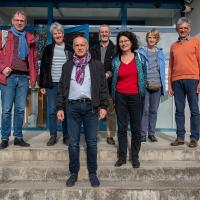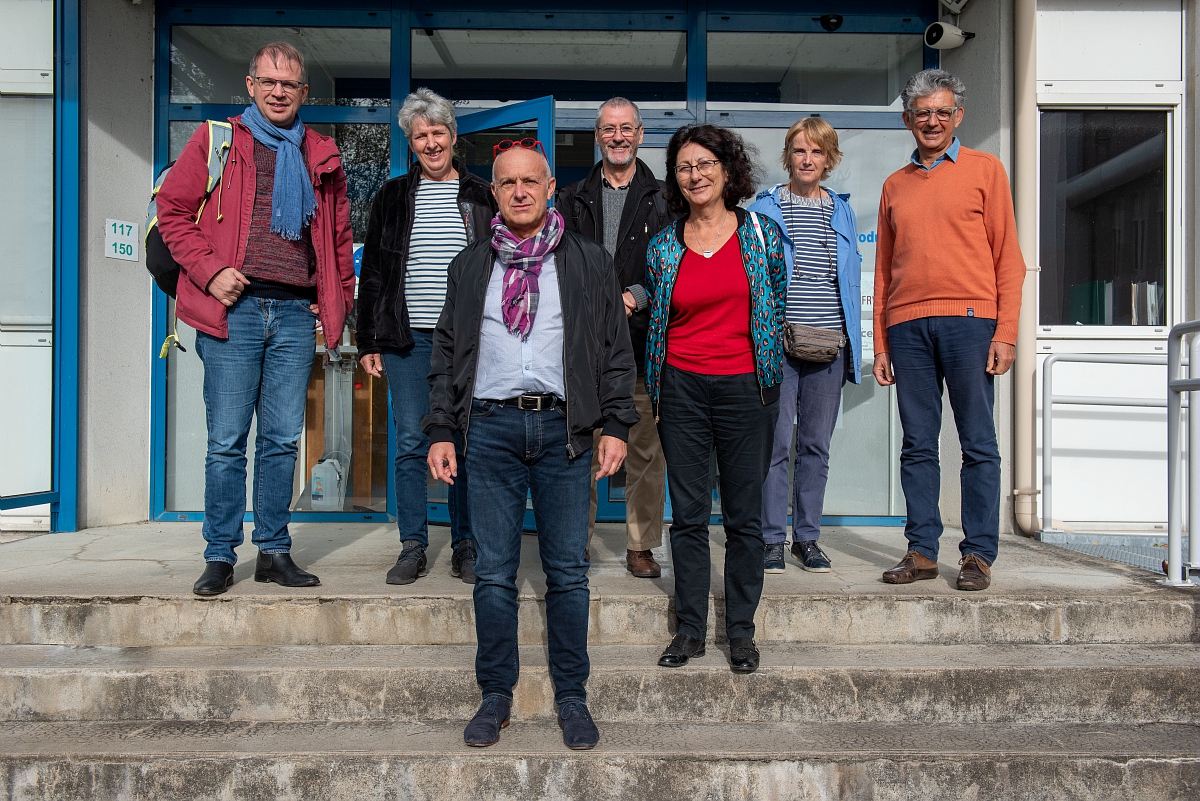
Agroecology Reading time 10 min
Animal welfare: a driving concern
Published on 29 November 2021
In relationships between humans and animals, respect is now extended to both parties, steps have been taken to minimise suffering and maximise quality of life
As recently as a few decades ago, the treatment of farm animals could generally be summarised in this way: “We must breed animals that better tolerate farming conditions, that are docile so as not to pose a threat to farmers. We need to limit stress before and during slaughter to preserve meat quality". These days, the reverse is true. Farming systems are being adapted to better meet animals’ needs. In relationships between humans and animals, respect is now extended to both parties. Steps have been taken to minimise suffering and maximise quality of life. Indeed, a profound societal revolution has taken place since the 1980s. Over the last 40 years, the field of ethology has matured and established complementary ties with other disciplines, including physiology, neurobiology, genetics, and sociology, which has given rise to new areas of research.
This year’s award winners are masters of cross-disciplinary approaches, which they have applied to produce research of international import. Their discoveries have brought about concrete changes in how farm animals are treated.
Deciphering the emotional lives of animals
INRAE ethologists have developed rigorous approaches for studying the emotional states of farm animals. They have found that farm animals, like humans, feel fear when faced with novel situations and express frustration when reality differs from their expectations. Predictability is reassuring, as is the ability to control environmental conditions. Other similarities have been discovered between farm animals and humans: the importance of relationships between mothers and offspring, and, more globally, of social bonds. Farm animals also display strong cognitive capacities. INRAE neurobiologists have shown that, in mammals, similar brain structures are involved in different behavioural displays of emotion.
“Although it remains challenging to functionally characterise the mental states of animals, we have made considerable progress in identifying objective signs of their emotions,” comments Alain Boissy. These advances were parlayed into the EU programme Welfare Quality®, which, in 2010, developed a standardised European system for evaluating animal welfare. This system includes measurements to be performed on animals, methods for characterising animal health and behaviour, and techniques for quantifying farming conditions. “It was an exciting adventure that involved six years of work!” exclaims Isabelle Veissier, who led the working group that developed the multicriteria model for evaluating animal welfare.
INRAE scientists wrote two joint scientific reports of unprecedented scope that focused on animal pain (in 2009) and animal consciousness (in 2017). The reports shone a spotlight on this research. At the time, discussing the possibility that animals are conscious beings was still taboo. However, neurobiologists had identified regions of the brain involved in consciousness in both animals and humans. These areas occur in the cortex and in subcortical structures. Claudia Terlouw has performed singular research exploring the neurobiology behind animal-stunning methods and assessing the state of unconsciousness in animals.
Societally relevant science
By building positive relationships with livestock, agricultural professionals can find greater satisfaction in their work and bring their approaches up to speed with societal expectations
A range of tools can be used to promote farm animal welfare. Armelle Prunier finds that imposing regulatory requirements can be quite powerful, as illustrated by the example of piglet castration. She notes: “First, it was essential to show that this practice is painful for animals. Castration is specifically used to reduce boar taint, foul-smelling odours in pork.” Armelle characterised piglets’ behavioural and physiological responses (i.e., the release of cortisol, adrenocorticotropic hormone, and adrenaline) to the stress of castration. She demonstrated these responses disappear when an analgesic is employed. Her work helped drive recognition of the fact that piglets experience pain during the procedure. Gradually, the system is changing. In 2012, piglets began systematically receiving anti-inflammatory drugs prior to castration, an industry-level action aimed at reducing animal pain. In 2022, regulations requiring the use of anaesthesia will come into effect. However, the ideal solution remains finding alternatives to castration. Armelle has identified blood markers that are linked to the production of undesirable odours, which could be exploited in breeding programmes. She believes it is possible to bring an end to piglet castration within about ten years.
Another powerful tool for promoting farm animal welfare is focusing on the well-being of farmers, who are affected by the suffering of their animals. Xavier Boivin has shown that farmers can build positive relationships with livestock via practices rooted in a better understanding of animal biology. As a result, agricultural professionals can find greater satisfaction in their work and bring their approaches up to speed with societal expectations. This innovative method is called One Welfare and fosters the mutual well-being of humans and animals. Farmers are also looking to learn and have adopted Welfare Quality® standards developed in concert with French agricultural technical institutes. These standards take the form of various simple toolkits: Boviwell for cattle, Beep for pigs, Ebene for poultry and rabbits, and Moubiene for sheep.
Communicating with consumers
To meet consumer expectations, many brands are directly addressing concerns about animal welfare. Various third-party labelling schemes are in development. “However, it is essential that a scheme’s criteria be transparent for consumers and that they be defined from a farm animal perspective,” highlights Alain Boissy, who is working alongside Pierre Mormède in an ANSES working group to build a French labelling scheme. At present, there are about ten EU labelling schemes. For example, eggs are classified according to hen rearing system (organic, free range, or conventional). Recently, an animal welfare labelling scheme for broilers was launched by AEBEA, a non-profit organisation that brings together producer collectives, product distributors, and animal protection groups. Boviwell indicators are being incorporated into the Label Rouge scheme (e.g., which affects 5–10% of beef production). That said, animal welfare indicators represent a small number of the broad range of indicators used to characterise farming conditions, which are generally easier to measure. Clearly, the animal welfare research network still has a lot on its plate.
What's next?
INRAE is recruiting researchers in the neurosciences and behavioural sciences with a view to expanding the network. The next step is to embark on new lines of research, including the following:
- Developing new technologies (sensors, machine learning) to automate observations of animal behaviour and thus detect anomalies early on so that farmers can act quickly
- Better incorporating behavioural criteria in breeding programmes to produce animals that are more robust and better adapted to less intensive farming systems: “For example, poultry could be bred in such a way that males could also serve as finishers, even if hen productivity declines,” comments Pierre Mormède.
- Coupling research with outreach—Launched in 2017 by the Ministry of Agriculture and Food and led by INRAE, the French Reference Centre for Animal Welfare (CNR BEA) plays a key role in promoting more animal-friendly farming systems by disseminating knowledge to the public, promoting exchanges among stakeholders, and informing government policies.

SOME IMPORTANT DATES AND SUCCESSES
INRAE's impacts
- 1980–1990: First animal behaviour research teams are established (Jean-Pierre Signoret and Pierre Le Neindre)
- 1995–2021: Cattle are genetically characterised to improve docility, and farmers/breeders train with France Limousin Selection and IDELE
- 1998: AgriBEA network is created (Robert Dantzer)
- 2005–2010: EU programme Welfare Quality® develops a system for evaluating animal welfare
- 2009: INRAE prepares a joint scientific report on animal pain
- 2011: INRAE PhD founds the ETRE Bureau for animal welfare, which provides auditing and consulting services in relation to farming systems, slaughtering practices, and labelling schemes
- 2017: INRAE prepares a joint scientific report on animal consciousness
- 2017: French Reference Centre for Animal Welfare is launched
- 2018: MOOC on farm animal welfare is created
Key regulations
- 1998: Council directive is passed concerning the protection of animals kept for farming purposes (1998/58/EC)
- 2015: Animals are granted a new legal status in French civil code (article 515-14)
- 2016–2020: French Ministry of Agriculture and Food develops the first-ever strategy for animal welfare
- Calves—1991 and 2008: Directives are passed related to calf living conditions (91/629/EEC, 2008/119/EC); 2006: EFSA opinion is published addressing the risks for calves kept isolated in cubicles in intensive farming systems
- Pigs—1991 and 2008: Directives are passed related to pig living conditions (91/630/EEC, 2008/120/EC); 2003 and 2006: EFSA opinion is published addressing pig castration and tail docking; 2012: industry stakeholders commit to reducing piglet pain during castration via the administration of meloxicam; 2022: piglets must be anaesthetised prior to castration
- Poultry—Directive (1999/74/EC) is passed related to the protection of laying hens; Directive (2007/43/EC) is passed related to the protection of broilers
RESEARCH COMPLEMENTARITY WITHIN INRAE'S ANIMAL WELFARE NETWORK
-
Ethologist Alain Boissy has identified displays of emotion in animals and has characterised the social behaviour of ruminants. He is director of the French Reference Centre for Animal Welfare (CNR BEA; https://www.cnr-bea.fr/en) and serves as an animal welfare expert at ANSES. Affiliation: Joint Research Unit on Herbivores, INRAE Centre of Clermont-Auvergne-Rhône-Alpes.
-
Ethologist Xavier Boivin studies the relationships between humans and animals in collaboration with ergonomists and sociologists. He is on the board of the joint technology network One Welfare. Xavier also developed the multimedia training kit, Quality Handling, whose distribution is managed by French agricultural technical institutes. Affiliation: Joint Research Unit on Herbivores, INRAE Centre of Clermont-Auvergne-Rhône-Alpes.
-
Behavioural neurobiologist Frédéric Lévy studies maternal behaviours in sheep using MRI. Affiliation: Joint Research Unit for Reproductive and Behavioural Physiology, INRAE Centre of Val de Loire.
-
Ethologist Marie-Christine Meunier-Salaun has worked on pig feeding and parenting behaviours. She helped develop the Welfare Quality® system and encouraged its adoption by the animal production industry (Beep and Ebene toolkits). Affiliation: Joint Research Unit for the Physiology, Environment, and Genetics of Animals and Livestock Systems, INRAE Centre of Bretagne-Normandie.
-
Physiologist, geneticist, and emeritus research director Pierre Mormède has studied stress in pigs and rats. He serves as an animal welfare expert at ANSES and chairs the ethics committee on animal experimentation.
-
Physiologist and ethologist Armelle Prunier has explored stress and pain responses in pigs, notably in relation to castration. Affiliation: Joint Research Unit for the Physiology, Environment, and Genetics of Animals and Livestock Systems, INRAE Centre of Bretagne-Normandie.
-
Physiologist and ethologist Claudia Terlouw has spent the last 30 years researching the causes of animal stress before and during slaughter and has identified reliable signs of unconsciousness in stunned animals. Affiliation: Joint Research Unit on Herbivores, INRAE Centre of Clermont-Auvergne-Rhône-Alpes.
-
Ethologist and physiologist Isabelle Veissier coordinated a working group within the Welfare Quality® and AWIN programmes (2004–2014), whose results laid the foundation for the standardised system that is used in Europe to evaluate animal welfare. Affiliation: Joint Research Unit on Herbivores, INRAE Centre of Clermont-Auvergne-Rhône-Alpes.
For more information, see the following reports (in French):
